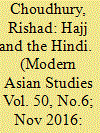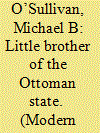|
|
|
Sort Order |
|
|
|
Items / Page
|
|
|
|
|
|
|
| Srl | Item |
| 1 |
ID:
149091


|
|
|
|
|
| Summary/Abstract |
This article charts several historical paths, hitherto underexplored, through the Hindi or ‘Indian’ Sufi lodges of the Ottoman empire. Focusing on the ‘long eighteenth century (circa 1695–1808)’, it tracks their remarkable ascendance as an institutional network for mobile and migrant Indian Sufi pilgrims. From Istanbul to the provinces, the article demonstrates how Naqshbandis and Qadiris on the Hajj circuit drew on local channels of social communications, legal petitioning strategies, and state and inter-state linkages to forge unique identities as ‘trans-imperial subjects’ in an age of decentralization in the Ottoman world. I argue that central to their social success was the creation of new corporate regimes of itinerant piety. But first, I place the little-known lodges at the heart of a specific shift in early modern attitudes to identity, as the story behind ‘Hindi’ beckons wider inquiry into emergent differences among Sufi pilgrims in the Ottoman empire.
|
|
|
|
|
|
|
|
|
|
|
|
|
|
|
|
| 2 |
ID:
149092


|
|
|
|
|
| Summary/Abstract |
This article explores the strategies of pandas (Hindu pilgrimage priests) in Vrindavan, relating changes in their trade (pandagiri) to tourism. These changes are the result of the pandas’ creative adjustments to shifting travel patterns that affect their market niche. Utilizing audio-recordings of the pandas’ guided tours, the article first portrays how pandas acquire ritual income from pilgrims by ‘inspiring’ donations of which they get a percentage. While commercial interests and economic conditions have always been crucial in shaping and perpetuating pilgrimage institutions and practices, global tourism has become an increasingly significant factor. Pandas all over India modify their services while the traditional exchange model (jajmani system) wanes. Changing travel patterns have made the guided tour a crucial component in the operation of Hindu pilgrimage. Vrindavan pandas have therefore turned into guides conducting religious sightseeing tours (darshan yatra). These tours are core to the new strategy for acquiring ritual income. To secure clients, pandas build connections with travel agencies and drivers and, in some cases, establish their own travel agencies that combine priestly and tourism services. The pandas’ own understandings of their methods and contemporary travel trends further reflect the dynamic interplay between pilgrimage and tourism in India.
|
|
|
|
|
|
|
|
|
|
|
|
|
|
|
|
| 3 |
ID:
149089


|
|
|
|
|
| Summary/Abstract |
By charting the activities of Ottoman experts in Afghanistan from 1908–23, this article demonstrates how their arrival precipitated a series of state-building practices rooted in the particular historical experience of Ottoman reform projects. The country thus became the object of an Ottoman mission civilisatrice and the beneficiary, in the eyes of certain figures within the Ottoman Committee of Union and Progress, of an avowedly Ottoman-Turkish modernity. Sharing this conviction were members of the Afghan royal family and its chief ministers, especially Maḥmūd Ṭarzī, who first invited the Ottoman advisers to Kabul. The provision of Ottoman technical assistance took a variety of forms, but is most evident in military, educational, and public health reforms enacted in Kabul in this period. Through the study of previously unexamined Ottoman, Afghan, and British sources, the aim here is to incorporate these events into discussions of Ottoman informal empire, Afghan developmentalism, and pan-Islam.
|
|
|
|
|
|
|
|
|
|
|
|
|
|
|
|
| 4 |
ID:
149095


|
|
|
|
|
| Summary/Abstract |
This review article provides a reading guide to scholarly literature published in English about Nepal's political transformation since 2006, when Nepal's decade-long civil conflict between Maoist and state forces formally ended. The article is structured around four major themes: (1) the Maoist insurgency or ‘People's War’; (2) state formation and transformation; (3) identity politics; and (4) territorial and ecological consciousness. We also address the dynamics of migration and mobility in relation to all of these themes. Ultimately, we consider the Maoist movement as one element in a much broader process of transformation, which with the benefit of hindsight we can situate in relation to several other contemporaneous trajectories, including: democratization, identity-based mobilization, constitutional nationalism, international intervention, territorial restructuring, migration and the remittance economy, and the emergence of ecological and other new forms of consciousness. By looking across the disciplines at scholarship published on all of these themes, we aim to connect the dots between long-standing disciplinary traditions of scholarship on Nepal and more recent approaches to understanding the country's transformation.
|
|
|
|
|
|
|
|
|
|
|
|
|
|
|
|
| 5 |
ID:
149094


|
|
|
|
|
| Summary/Abstract |
This article explores the politicization of ethnicity in Nepal since 1990. In particular it looks at how ideas of indigeneity have become increasingly powerful, leading to Nepal becoming the first and—to date—only Asian country to have signed International Labour Organization Convention number 169 (hereafter ILO 169). The rise of ethnic politics, and in particular the reactive rise of a new kind of ethnicity on the part of the ‘dominant’ groups—Bahuns (Brahmans) and Chhetris (Kshatriyas)—is the key to understanding why the first Constituent Assembly in Nepal ran out of time and collapsed at the end of May 2012. This collapse occurred after four years and four extensions of time, despite historic and unprecedentedly inclusive elections in April 2008 and a successful peace process that put an end to a ten-year civil war.
|
|
|
|
|
|
|
|
|
|
|
|
|
|
|
|
| 6 |
ID:
149087


|
|
|
|
|
| Summary/Abstract |
This article examines pacification operations conducted by British colonial armies throughout the Maratha Deccan from 1803 to 1818. The East India Company assembled concentrations of coercive force by extending patronage to loyalist elites and mobile war bands. Military contingents from allied princely states were mobilized and combined with a policy of brokerage intended to demobilize hostile forces holed up in forts or engaged in brigandage. Pacification through a mixture of negotiations and force ensured loyalist groups a privileged place in the emerging colonial order.
|
|
|
|
|
|
|
|
|
|
|
|
|
|
|
|
| 7 |
ID:
149093


|
|
|
|
|
| Summary/Abstract |
This article examines the history and effects of Buddhist constitutionalism in Sri Lanka, by which is meant the inclusion of special protections and status for Buddhism in the island's 1972 and 1978 constitutions, alongside guarantees of general religious rights and other features of liberal constitutionalism. By analysing Sri Lankan constitutional disputes that have occurred since the 1970s, this article demonstrates how the ‘Buddhism Chapter’ of Sri Lanka's constitution has given citizens potent opportunities and incentives for transforming specific disagreements and political concerns into abstract contests over the nature of Buddhism and the state's obligations to protect it. Through this process, a culture of Buddhist legal activism and Buddhist-interest litigation has taken shape. This article also augments important theories about the work of ‘theocratic’ or religiously preferential constitutions and argues for an alternative, litigant-focused method of investigating them.
|
|
|
|
|
|
|
|
|
|
|
|
|
|
|
|
| 8 |
ID:
149088


|
|
|
|
|
| Summary/Abstract |
From the fourteenth century CE onwards, South Indian states ruled by Hindu kings were strongly influenced by politico-cultural conventions from Muslim-governed areas. This development was, for instance, manifest in the dress and titles of the rulers of the Vijayanagara empire. As has been argued, they bore the title of sultan and on public occasions they appeared in garments fashioned on Persian and Arab clothing. Both adaptations exemplified efforts to connect to the dominant Indo-Islamic world. From Vijayanagara's fragmentation in the sixteenth and seventeenth centuries, new Hindu-ruled kingdoms arose. We may wonder to what extent those succeeding polities continued practices adopted from Islamic courts. With that question in mind, this article discusses royal dress at court audiences in four Vijayanagara successor states, chiefly on the basis of embassy reports of the Dutch East India Company and South Indian works of art. It appears that kings could wear a variety of clothing styles at audiences and that influences on these styles now came from multiple backgrounds, comprising diverse Islamic and other elements. Further, not all successor states followed the same dress codes, as their dynasties modified earlier conventions in different ways, depending on varying political developments.
|
|
|
|
|
|
|
|
|
|
|
|
|
|
|
|
|
|
|
|
|